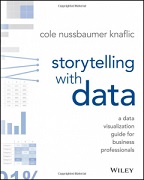 A book just came across my desk, “Storytelling with Data – A Data Visualization Guide for Business Professionals,” by author Cole Nussbaumer Knaflic, that is a handy resource for data scientists of all levels of experience. It is an important job of data scientists to engage in “data storytelling” to communicate the results of their machine learning projects. All the popular language environments have data visualization tools, like pandas for Python and ggplot2 for R. These tools can make beautiful graphs. The problem is that you can still make common mistakes that render your graphs less powerful in their message. Enter this new book to help pave the way.
A book just came across my desk, “Storytelling with Data – A Data Visualization Guide for Business Professionals,” by author Cole Nussbaumer Knaflic, that is a handy resource for data scientists of all levels of experience. It is an important job of data scientists to engage in “data storytelling” to communicate the results of their machine learning projects. All the popular language environments have data visualization tools, like pandas for Python and ggplot2 for R. These tools can make beautiful graphs. The problem is that you can still make common mistakes that render your graphs less powerful in their message. Enter this new book to help pave the way.
Nobody sets out the make a bad business graphic. But it happens more often than you’d think – at every organization, throughout all industries and by all types of people. It happens in the media. It happens in places least expected, by professionals who should know better. This new resource explains why this happens and how to fix it.
We aren’t naturally good at storytelling with data,” says author Cole Nussbaumer Knaflic. “In school we learn a lot about language and how to create stories with our words; and we learn a lot about math and how to make sense of numbers. But it’s rare that these two sides are paired: No one teaches us how to tell stores with numbers.”
In her new book, Nussbaumer Knaflic expands upon the lessons taught in her storytelling with data workshops. It explores the fundamentals of data visualization and how to communicate effectively with data. It illuminates the power of storytelling and the way to make data a pivotal point in a story. The lessons are grounded in theory, but made accessible through numerous real-world examples – ready for immediate application.
Technology has enabled us to amass greater and greater amounts of data and there is an accompanying growing desire to make sense out of all this data. Being able to visualize data and tell stories with it is key to turning it into information that can be used to drive better decision making,” says Nussbaum Knaflic. “While technology has increased access to and proficiency in tools to work with data, there remain gaps in capabilities. Pretty much anyone can put some data in Excel and create a graph. This can render the most interesting story underwhelming, or worse – difficult or impossible to understand.”
The book demonstrates how to go beyond conventional tools to reach the root of your data, and how to use your data to create an engaging, informative, compelling story. Specifically, the book shows readers how to:
- Understand the importance of context and audience
- Determine the appropriate type of graph for specific situations
- Recognize and eliminate the clutter clouding information
- Direct an audience’s attention to the most important parts of data
- Think like a designer and utilize concepts of design in data visualization
- Leverage the power of storytelling to help a message resonate with your audience
This book is written for anyone who needs to communicate something to someone using data,” Nussbaumer Knaflic adds. “Effective data visualization can mean the difference between success and failure when it comes to communicating finding of a study, raising money for a non-profit or business, presenting to a board, or simply getting your point across to your audience.”
I would add communicating data science results to this list. Data visualization, and communicating with data in general, sits at the intersection of science and art. Use this book to rid the world of ineffective graphs, one exploding 3D pie chart at a time.
As an educator, I plan to recommend this book as a supplemental resource for my next Introduction to Data Science course. With this book as a guide for quality business graphs, the next resource we need is a library of R and Python code to implement all the recommendations found in the book. Any volunteers?
Sign up for the free insideBIGDATA newsletter.





Speak Your Mind